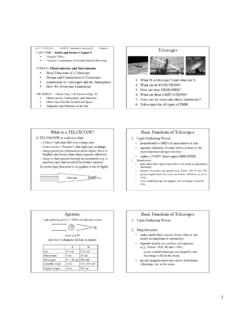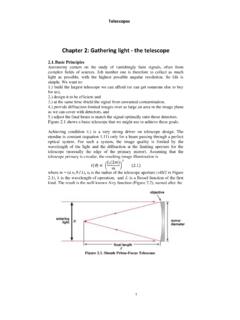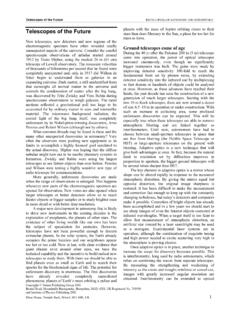Transcription of The Spitzer Space Telescope - IRSA
1 The Spitzer Space TelescopeMichael WernerDownloaded from SPIE Digital Library on 09 Feb 2012 to Terms of Use: Spitzer Space TelescopeMichael WernerCalifornia Institute of TechnologyJet Propulsion LaboratoryPasadena, California 91107E-mail: Spitzer Space Telescope , which has operated very suc-cessfully since 2003 in its unique Earth-trailing solar orbit, is NASA sGreat Observatory for infrared astronomy. We provide a quick overviewof the optical characteristics of Spitzer and review the observatory main emphasis is on two unique on-orbit activities used to optimizethe scientific return from Spitzer : 1. an unusual approach to focusing thetelescope that minimized the use of the cryogenic focus mechanism, and2. a methodology for extending the cryogenic lifetime of Spitzer by activelycontrolling the Telescope temperature. 2012 Society of Photo-Optical Instrumen-tation Engineers (SPIE).[DOI: ]Subject terms: cryogenic systems; infrared; Space Telescope ; Spitzer ; telescopefocus; thermal 110711 SSP received Jun.
2 23, 2011; revised manuscript received Sep. 26,2011; accepted for publication Oct. 12, 2011; published online Feb. 3, IntroductionThe launch of the National Aeronautics and Space Admin-istration s Spitzer Space Telescope ( Spitzer ) in August 2003provided the scientific community the most powerful tool yetavailable for astronomical explorations between and160 m. Spitzer combines the intrinsic sensitivity of a cryo-genic Telescope in Space with the tremendous imaging andspectroscopic capabilities of the new generation of infrareddetector arrays. Spitzer s unique cryothermal architectureand Earth-trailing solar orbit have enabled the spacecraftto continue operating in a totally passively cooled configura-tion for more than two years after the depletion of the 350 Lof liquid helium carried at launch. Well over 2000 papersbased on Spitzer studies of objects from near-Earth asteroidsto the most distant known galaxies have appeared in therefereed literature since launch, and the observatory remainsas robust and productive as Spitzer Telescope is not remarkable in comparison tocontemporaneous and future Space -optical systems.
3 In thiscontribution, we provide a quick overview of the Spitzertelescope but concentrate principally on two activities car-ried out during the mission that are of particular technicalinterest the process by which the Telescope was focusedon orbit and the approach used to extend the liquid heliumlifetime by matching the Telescope temperature to the needsof each scientific instrument in turn. Readers seeking a morecomplete end-to-end technical description of Spitzer , includ-ing the instruments and the operations, are referred to Gehrzet Rieke3have presented historical accountsof the development of Spitzer . Summaries of the scientificbounty of Spitzer are presented by Werner et Soiferet al.,5and in the proceedings of the 2009 Spitzer The Spitzer TelescopeThe Spitzer optical design is a conventional Ritchey Chretien two-mirror system. The primary and secondarymirrors and the metering tower that connects them are allfabricated from hot isostatically pressed (HIP) berylliumto maintain alignment and minimize stresses on coolingfrom room temperature to the operating temperature of5 K.
4 Beryllium was the material of choice because of itslightweight, good thermal properties, and high strength-to-mass ratio. The Telescope has a 90-cm-diameter mirror, fig-ured and stopped down to produce an 85-cmf aperture, and a 12-cm-diameter secondary secondary mirror is mounted on a cryogenic focusmechanism, which provides high-precision motion in theaxial direction and was used to focus the Telescope assembled optical system ( ) has a length of about90 cm. The mass of the fully assembled Telescope , includingmirrors, metering tower, focus mechanism, barrel baffle, andthe hardware required to mount it to the Spitzer cryostat, is55 kg. The focal length is m and the plate scale is20 arcsec mm. Fabrication of the Telescope was begun atHughes-Danbury (now Goodrich) and finished at Ball Aero- Space . The mirrors were figured by Tinsley Laboratories, andmuch of the cryogenic testing was done at the Jet PropulsionLaboratory (JPL).The Telescope was required to provide diffraction-limitedimages at a wavelength of m over a 30-arcmin field ofview.
5 This corresponds to a wavefront error of m at thefocal plane; when this was flowed down to and through thetelescope, the corresponding requirement on the primarymirror surface error was m rms at the operating tem-perature of 5 K. Because the primary was figured at roomtemperature, the process of guaranteeing satisfactory cryo-genic performance was neither trivial nor initial preparation of the material and annealing/stress relief during the figuring allowed the optics team toestablish by test that the mirror deformed predictably ( ,without hysteresis) on successive cooldowns. The finalfigure was thus achieved by measuring the mirror figure atoperating temperature in a cryogenic test facility at JPL,comparing the cryogenic figure with the room-temperaturefigure, and taking the difference. This defined a hit map specifying the changes to be polished into the mirror atroom temperature so that the mirror would distort into therequired optical configuration upon cooldown.
6 Two cyclesof this process, referred to by the ungainly name of cryonullfiguring, brought the primary mirror to a surface error of0091-3286/2012/$ 2012 SPIEO ptical Engineering011008-1 January 2012/Vol. 51(1)Optical Engineering 51(1), 011008 (January 2012)Downloaded from SPIE Digital Library on 09 Feb 2012 to Terms of Use: m rms, exceeding the requirement established in theerror assembled Telescope , the instruments, and the Spitzercryogenic system (also provided by Ball) underwent end-to-end optical and cryogenic testing in the BRUTUS chamber atBall Aerospace. The optical tests used an autocollimating flatilluminated by a thermal source in the Spitzer focal plane thatwas reimaged by the Telescope and detected by the shorterwavelength instruments. This test, described in detail byGehrz et al.,1,7established that the system optical qualitymet predictions and requirements, and also allowed thesecondary mirror to be set to place the Telescope focus atthe optimum prelaunch Spitzer observatory, shown in , includes thetelescope, scientific instruments, the cryothermal systemthat maintains the instruments and the Telescope at appropri-ate low temperatures for sensitive infrared studies, and thespacecraft.
7 Lockheed-Martin provided the spacecraft andthe solar panel and its Focusing the of the Focal Plane InstrumentsSpitzer has three focal plane instruments: Infrared Array Camera (IRAC; principal investigatorGiovanni Fazio, Smithsonian Astrophysical Observa-tory), which operates in four bands from to 8 256 pixelsarray operated in each of the fourbands. The IRAC observed two almost adjacent5 5 arcminfields of view. Each was viewed by twoof the four arrays, by using a dichroic to separate theincoming light into two bands. Thus, one IRAC field ofview was imaged simultaneously at and m,and the other at and 8 m. Infrared Spectrometer (IRS; principal investigatorJames Houck, Cornell University) with four modulescovering wavelengths from to 38 m. The IRS pro-vided long-slit, low-resolving power (R 100) from 38 m and higher resolution (R 600) spectroscopy inechelle mode from 10 to 35 m. All four modules wereinstrumented with128 128 pixelsarrays.
8 A smallsection of one of the spectroscopic arrays could beused as a camera. This permitted the observatory toobtain an infrared image, autonomously locate aninfrared source, and offset the observatory to place iton a spectrometer slit. This peak-up array could alsobe used for photometry at 15 m. Multiband Imaging Photometer for Spitzer (MIPS;principal investigator George Rieke, Arizona) imagedin three bands from 24 to 160 m. Its 24- m array also with128 128 pixels had a5 5 arcminfieldof view. The 70- and 160- m arrays had fewer pixelsand somewhat smaller fields of view but neverthelessprovided excellent sampling of the Telescope also had a low-resolution spectroscopic mode(R~20) for spectrophotometry from 50 to 100 incorporated the only mechanism in thepayload a scan mirror that enabled efficient mappingof large three instruments ( ) shared the 30-arcmin fieldof view; each was illuminated by mirrors that picked off por-tions of the focal plane and reflected them into the instrumentapertures.
9 The mirrors and the instrument apertures werefixed; the secondary mirror was the only optical elementaffecting the Telescope focus that could be moved onorbit. In addition, the focal plane contained several visibleFig. 1 Spitzer Telescope . This picture shows the assembled opticalsystem primary mirror, metering tower, secondary mirror (notvisible), and focus mechanism atop the 2 Cut-away view of the Spitzer Observatory. The observatory isabout 4 m tall and has a launch mass of 870kg. The dust cover atopthe Telescope outer shell in this drawing was jettisoned a few daysafter launch; the cryostat aperture door was opened shortly : The Spitzer Space TelescopeOptical Engineering011008-2 January 2012/Vol. 51(1)Downloaded from SPIE Digital Library on 09 Feb 2012 to Terms of Use: sensors, small PIN diode arrays referred to as the point-ing calibration reference sensor (PCRS). The PCRS was usedto observe visible stars that were observed at the same timeby the external star tracker mounted to the spacecraft established and maintained the registration of the cryo-genic field of view with the reference frame of the startracker, which was used for target the shortest wavelength instrument, the IRAC leviedthe most severe requirements on the Telescope image minimize the image degradation due to design residuals,the IRAC fields of view were placed as close as possible tothe center of the focal MethodologyThe nominal method for focusing an astronomical telescopeis to carry out a focus sweep in which the secondary mirroris stepped through a range of positions intended to move thefocal point through the optimum position.
10 Images are takenat each secondary mirror position and the optimum focussetting is established. This method was considered highlyundesirable for Spitzer because of the unknown risk inherentin repeated and lengthy actuation of the cryogenic focusmechanism. An alternate methodology was developed, con-sisting of the following elements:1. Careful design and subsequent metrology of all threeinstruments and the PCRS made it possible to placeeach module and its pick-off mirrors so that the mod-ules were confocal to well within the depth of focus foreach. This would make it possible to have acceptableimage quality at each instrument aperture at a singlesetting of the secondary mirror s focus designed and installed fiducials placed onthe outside of each instrument made it possible tocheck this confocality even after the focal plane wasentirely assembled within the cryostat, prior to cool-down on the ground. This confocality ensured that ifthe IRAC were in focus, as verified by observationsof stars on orbit, then all of the instruments wouldbe in focus.









